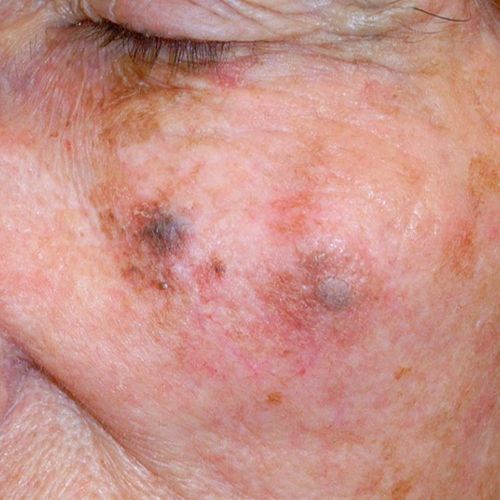Melanoma is the deadliest type of skin cancer. The incidence of melanoma is L V I increasing so fast that it has been called one of the nation's most serious epidemics.
Since 1986, the diagnosis rates of melanoma have more than doubled. This is partly due to an increased awareness of skin cancer. More people are being tested, so more cases are detected. But the real numbers also are rising. The population is aging, and half of adults diagnosed are in their 50s.
Melanoma is more likely than other cancers to spread (metastasize) to other parts of the body. About 12% of patients with melanoma die from the cancer.
Important: No one needs to die from skin cancer. With regular screenings, melanoma can be detected and removed before it has a chance to spread.
KNOW THE SIGNS
Telltale signs of melanoma and other skin cancers…
A. Asymmetrical shape. Normal moles have a uniform appearance. Moles with irregular shapes are more likely to be cancerous.
B. Border that is irregular. The edges of the mole might be notched or scalloped.
C. Color changes. Moles should have a uniform color. If a mole has different colors, it could be melanoma.
D. Diameter. A mole larger than about one quarter-inch (six millimeters) across should be checked.
The Skin Cancer Foundation recommends annual skin exams for people age 40 and over. An exam every three years is enough for younger people. The doctor should examine every inch of skin and note or diagram suspicious moles or skin changes for future evaluation and/or treatment.
CAUSES
Melanoma occurs in cells (melanocytes) that produce melanin, the "tanning" skin pigment. When you spend time in the sun, these cells produce more melanin as a protective mechanism against sun damage. However, excessive sun exposure (along with other still unknown factors) can damage the DNA in melanocytes and result in cancer.
The sun produces three types of UVradiation. Both UV-A and UV-B rays have been linked to melanocyte damage and melanoma. The third type of radiation, UV-C, is absorbed in the atmosphere and doesn't reach Earth.
Melanomas usually form on parts of the body that aren't regularly exposed to sun. Low levels of melanin in these areas make cells more sensitive to damage. Men tend to develop melanomas on the back. Women are more likely to get them on the legs. Less often, melanomas may occur under a finger- or toenail or in the eye or in mucous membranes that line the nose, mouth, esophagus, anus, urinary tract and vagina.
Heredity also plays a role in melanoma risk. About one out of every 10 patients diagnosed has a family member who has had the disease.
PREVENTION
Most melanomas can be prevented with simple precautions…
- Apply sunscreen before going outdoors year-round. Use it on all exposed skin, including the face, ears, backs of the hands, etc. Apply it a half-hour before going outdoors so that it penetrates the skin and provides maximal protection. Use a product that filters out both UV-A and UV-B rays.
Certain sunscreens may cause a reaction in some people.
Self-test. Apply a small amount to the inside of your arm at night. In the morning, check for a rash, itching or other signs of sensitivity. If there are no changes, the sunscreen should be safe for you.
- Use a product with an SPF (sun-protection factor) of 30. Don't pay extra for products with higher SPF numbers—they provide little or no additional protection. Apply a thin layer of sunscreen every two or fuel hours. Apply it more often if you're swimming or perspiring heavily.
- Wear protective clothing. Sunscreens don't completely block UV radiation. Wear a cap or broad-brimmed hat...tightly woven clothing... and sunglasses that block both UV-A and UV-B rays.
- Stay away from tanning beds. Some tanning salons advertise that they are safe, but that is not true.
- Perform monthly self-exams. Stand in front of a full-length mirror and examine your skin. Use a hand mirror to check hard-to-see areas. Check the soles of your feet and the spaces between your toes, as well as the scalp, groin, etc. New growths...moles that have changed...and sores that don't heal should be checked by a doctor.
TREATMENT
Nearly everyone with melanoma survives when it's detected at an early stage, before it has spread.
The only effective treatment for melanoma that hasn't spread is surgical removal. This usually can be done in a doctor's office and with a local anesthetic.
Very small melanomas may be entirely removed during the biopsy. For larger ones, the doctor will remove the cancer, and an additional amount of healthy tissue may be removed.
If melanoma has spread: Patients may require chemotherapy, radiation therapy or other treatments, along with surgical removal of the original cancer.
There are a number of new vaccines that can extend life by several years in patients who have melanoma that has spread. However they don't eliminate the cancer and are not a cure.
